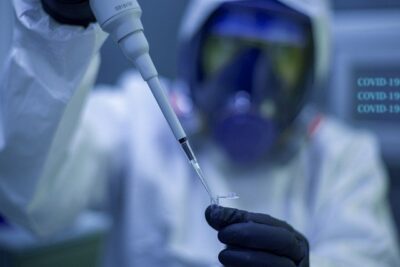In a new research scientists at Beth Israel Deaconess Medical Center (BIDMC) found that a candidate COVID-19 vaccine increases neutralizing antibodies against COVID-19, and prevents weight loss, pneumonia in animals.
Most people with COVID-19 have relatively mild disease, but a subset of people develop severe pneumonia and respiratory failure, potentially leading to death.
Beth Israel Deaconess Medical Center (BIDMC) immunologist Dan H. Barouch, MD, PhD, and colleagues showed in recently published previous work that a candidate COVID-19 vaccine raised neutralizing antibodies that robustly protected non-human primates against SARS-CoV-2.
Now, in new research published today in Nature Medicine, Barouch and colleagues demonstrated that the investigational vaccine elicited a robust immune response in Syrian golden hamsters and prevented severe clinical disease—including weight loss, pneumonia, and death (Mercado et al. 2020).
“We recently reported that an Ad26-based SARS-CoV-2 vaccine provided robust protection in rhesus macaques, and this vaccine is currently being evaluated in humans,” said Barouch, who is Director of BIDMC’s Center for Virology and Vaccine Research.
“However, nonhuman primates typically don’t get the severe clinical disease, and thus it was important to study whether this vaccine could prevent severe pneumonia and death due to SARS-CoV-2 in hamsters, which are more susceptible to clinical disease.”
The vaccine – developed through a collaboration between BIDMC and Johnson & Johnson (J&J)—uses a common cold virus, called adenovirus serotype 26 (Ad26), to deliver the SARS-CoV-2 spike protein into host cells, where it stimulates the body to raise immune responses against the coronavirus.
Barouch’s group and J&J developed a series of vaccine candidates designed to express different variants of the SARS-CoV-2 spike protein, which is the major target for neutralizing antibodies.
In the current study, the researchers immunized Syrian golden hamsters with a single injection of the Ad26-based SARS-CoV-2 vaccine, which induced neutralizing antibodies in all animals. Four weeks later, the animals were exposed to a high dose of SARS-CoV-2.
Vaccinated animals lost less weight and had less virus in their lungs and other organs than unvaccinated control animals. Vaccinated animals also demonstrated lower mortality. Moreover, the researchers found that neutralizing antibody responses were inversely correlated with weight loss and viral loads in respiratory tissues. The Ad26.COV2.S vaccine is currently being evaluated in clinical studies to establish the performance of the vaccine candidate in humans.

“This hamster model of severe COVID-19 disease should prove useful to complement current nonhuman primate models in the evaluation of candidate vaccines and therapeutics,” said Barouch, who is also the William Bosworth Castle Professor of Medicine at Harvard Medical School, a member of the Ragon Institute of MGH, MIT, and Harvard, and the co-leader of the vaccine working group of the Massachusetts Consortium on Pathogen Readiness.
In July 2020, investigators at BIDMC and other institutions initiated a first-in-human Phase 1/2 clinical trial of the Ad26.COV2.S vaccine in healthy volunteers. Kathryn E. Stephenson, MD, MPH, is the principal investigator for the trial at BIDMC, which is funded by Janssen Vaccines & Prevention, B.V., a pharmaceutical research arm of Johnson & Johnson.
Pending clinical trial outcomes, the Ad26.COV2.S vaccine is on track to start a phase 3 efficacy trial in up to 60,000 participants in September 2020.



















